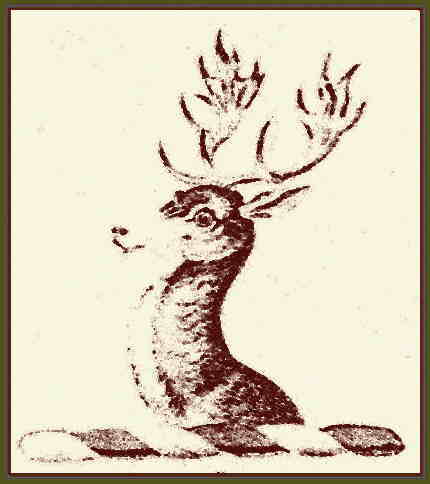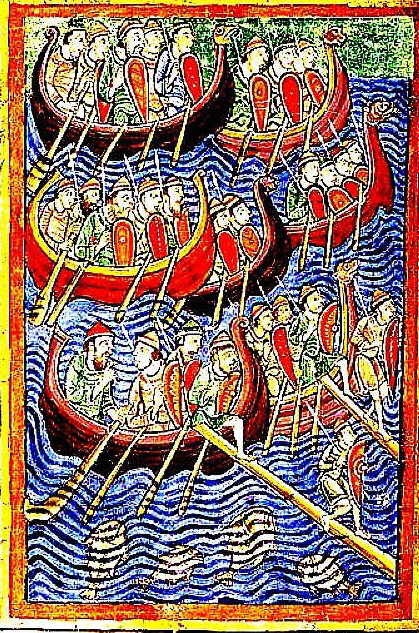Veritas vincit Traditional Stag Crest and Motto of Geddie - Geddes
Scottish Septs Related to the Geddie Name "The following... is from R. R. McIan's 'The Clans of the Scottish Highlands,' first published 1845 and presented, beautifully illustrated, to Queen Victoria. Politics most likely figured heavily into the makeup of the original document, as many well-established clans were left out. This should not be considered a list of all the clans and septs that existed at the time, but as a list of those that were thought worthy of inclusion by the nobility and clan chieftains at the time." Septs of Clan Geddes: Gordon and Rose Septs of Clan MacPhail: Cameron and Mackay
SURNAMES ASSOCIATED WITH CLAN MacDUFF GEDD From TARTAN FOR ME!, Third Edition, FIFE NAMES
The MacPhail's FROM CLAN CHATTAN CLAN PHAIL (MacPhail). Name taken from the Chief, Gilliechattan Mor, 'Great Servant of St. Catan. Lands in Glenlui, Loch Arkaig, Gellovie, Lochaber and Badenoch. One of the Chattan line, Ewan Ban, became the ancestor of Clan MacPherson.
From THE FORGING OF A FAMILY by Baron Auckland Campbell Geddes (c)1952
"The Ged’s land-ees is fair to see, With valleys broad and rivers three; Where Eske and Annan, and the Nith Flow softly to the Solway Firth". Auld Wullie, a vagrant, to Campbell Geddes as a child
The Geds The Scots are, relatively speaking, a modern people. They first appear on the stage in the fourth century as a people of mixed racial origin in that part of Hibernia which is now called Ulster. Their fathers were raiding Northmen; their mothers, indigenous Hibernians of dark Iberian stock, or Romano-British girls taken captive by the Northmen in their raids on the British coasts, or even girls from farther afield, from the Channel and Atlantic coasts of Gaul. As the fourth century advanced these heathen savages organised themselves in seven septs, each calling itself after some animal or thing which its members specially admired. One of them selected as its exemplar the most ferocious and voracious of freshwater fish, the pike, called, in the tongue of the Northmen, the ged. This is the origin of the Geddes name and the tap root of the Geddes stock. About the middle of the fourth century the half-breeds, the Scots, were extending their power over Hibernia; and in A.D. 389 their leader, Niall, proclaimed himself High King of Hibernia. Under this famous warrior - perhaps pirate would be a better word - the Scots took heavy toll of loot and women from Britain and Gaul. To meet the threat of their raiding squadrons Romano-British naval patrols were formed; and fortified bases for these, laid out on a new pattern, were established on the British coasts. This meant harder fighting for the Scots, for loot and girls. In one of these sea fights, under the lee of the Isle of Wight, in the year A.D. 405, Niall was killed. As the Romano-British squadrons gained in strength a new way of raiding Roman Britain was devised by the Scots. They established settlements in Britain itself, but north of the Wall of Hadrian. It was in a settlement of this type, somewhere in the upper Nith valley, that the Scottish Geddeses, the children of Niall, made their first home in Caledonia. Among the captive Romano-Britains carried off by the Scots in one of Niall’s raids was a boy of fifteen and his two sisters, whose father was a Rome civil servant and a deacon of the Christian Church. The boy, later known to fame as St. Patrick, was not enslaved in Hibernia, for he soon appears again in history as a pupil at the Candida Casa, as the bright whitewashed mission station of St. Ninian, at Whithorn in Wigtonshire, built in A.D. 397, was called. From the geographical juxtaposition of the Nith valley and the Candida Casa there is some plausibility in a tradition that young Patrick was actually captured by one of the Ged raiding parties. Of his sisters nothing further is known; but it may be fairly assumed that their fate was that of the women of whom we have already learned. There is nothing known about the early doings of the Geds of the Nith valley except that St. Ninian wrestled with their heathenism, and at some uncertain date they became, nominally, Christian. As was so often the case it may well be that their women, many of whom were christianised Romano-British captives, taught their children what they remembered of Christianity, and were themselves taught by the disciples of St. Ninian. It was not long before the whole of South-west Scotland was peopled by Scots, and this led to that district being called Galloway, which, being interpreted, means ‘the land of immigrant strangers.’ While the Geds were multiplying in Galloway other Scots were moving into Ayrshire, pushing up the Clyde valley, occupying Cantyre, and spreading out into Dumbarton and Argyll. Gradually they consolidated their organisation and formed the first Scottish kingdom in Caledonia-Dalriada. In the ebb and flow of tribal warfare Cumbria - a kingdom formed in the upper Clyde valley - spread its power to the western sea, cutting off the Scots of Galloway from direct contact with the Scots of Scotia, as the area they occupied north of the Clyde estuary had come to be called. This severance of the Geddeses in Galloway from their kinsmen to the northward forced on to the Geddes stock a peculiar isolation which was their main characteristic throughout the middle ages. They were the Moss Troopers - men of the Moss Hags - who rode, reived and raped with complete impartiality in any direction which promised a hope of loot of cattle, sheep and horses; especially horses, for they had now almost forsaken the sea and made their forays mounted. When the development of Romano-British sea power had forced the Scots to establish settlements in Caledonia the Romano-British reply to the new form of raiding was to establish mobile columns of armoured cavalry, whose Commander-in-Chief bore a title which may be rendered ‘Count of Britian.’ The natural reply of the raiders from north of the Wall to this military development was to turn themselves into highly mobile ‘light cavalry.’ If we think for a moment of straggling columns of fierce horsemen moving through the emptiness of northern England with its great forests, its marshes and moorland wastes, we get what is probably a not inaccurate picture of the life of our ancestors. The historical basis of the great body of legend, myth and poetry concerning King Arthur and his Knights is to be looked for in the heartfelt gratitude of the Romano-British people for the protection the armoured chivalry gave them from the swift and terrifying raiders - Scots, Angles, Saxons. Dispersal It is remarkable that for many generations, perhaps thirty, the Geddes stock produced no man of such outstanding ability as to force his way on to the pages of history. Reivers and cattle-lifters they were; and so they remained until the day came when neither Scotland nor England could tolerate them any longer. Then came dispersal, which scattered them over Scotland and even parts of England. Some, settling down in Lowland Scotland, became respectable and appear in Scottish history as the Geddeses of Rachan in Peeblesshire. Those finding refuge in England concealed their identity by adopting as their family name one of two variants of the Latin word for ‘Pike’ (lucitus) Luce or Lucy; or, in plain English, ‘Pike.’ [nb. "Lucas" has now been added to give us a third surname variant.] One party, a small one, escaped by sea to the far north of Scotland. They landed in the area of Loch Eriboll and offered their swords and services to the Chieftain of the Clan Mackay. It is from this party of Geddes refugees that [Auckland Campbell Geddes’ family] descend. These events belong, by date, to the middle of the fifteenth-century; and, be it noted, from that day to this there has been no blood connection between the Geddeses who landed at Eriboll and any others of their name or its variants. But all the Geddeses - and, so far as it is known, also those who call themselves Luce, Lucy and Pike - have retained in their crests, their arms and their badges the device of the Ged, either as a whole fish, swimming free, or its head; or, as in the arms of Geddes, as supporters of the central shield. The free-swimming Ged is, as a badge, much older than heraldry, and has nothing to do with noble birth. ‘Sharing-Knowe’: Mount Sharon At the time of the dispersal a handful of the Geds managed to stay in their old homeland, and in the second quarter of the sixteenth century we find them turning themselves into country gentlemen, building houses and accepting grants of arms. Sir Walter Scott, who knew the Border and Galloway country as few have known it, gives a vivid picture of what their descendants had become in his day, in the seventh letter of his Preface to Redgauntlet. Here is his description of a visit to the house and grounds on the old ‘Sharing-Knowe’ - the place where garnered loot was portioned out. The owner was a Quaker called Joshua Geddes. Scott says : He ‘proceeded to solicit my attention to the natural objects around us. . . . Our course lay through a little gate, into a pathway kept with great neatness, the sides of which were decorated with trees and flowering shrubs . . . (till finally) . . . my guide, shaking me cordially by the hand, made me welcome to Mount Sharon. . . . `The house fronted to the south-east, and from thence . . . the gardens sloped down to the water. . . . With their shaven turf pleached alleys and exotic trees and shrubs (they) greatly excelled anything of the kind which had been attempted in the neighbourhood. . . . ‘Joshua Geddes conducted me to a small sashed door opening . . . into a parlour of moderate size; the furniture of which in plainness and excessive cleanliness bore the characteristic marks of the sect to which the owner belonged. . . . The parlour chimney engaged my attention. It was a pile of massive stone, entirely out of proportion. . . . On the front had once been an armorial scutcheon; for the hammer . . . which had been employed to deface the shield . . . had left uninjured the scroll beneath, which bore the pious motto ‘Trust in God.’ . . . ‘Joshua Geddes paused when he saw my eye fixed on this relic of antiquity. ‘Thou canst read it?’ he said. ‘I repeated the motto and added there seemed to be vestiges of a date. ‘It should be 1537,’ said he; ‘for so long ago . . . did my ancestors, in the blinded times of Papistry, possess these lands and in that year did they build their house.’ ‘Vanity of Vanities, saith the preacher’ - thus harangued Joshua Geddes; ‘if we ourselves are nothing in the sight of Heaven how much less than nothing must be our derivation from rotten bones and mouldering dust whose immortal spirits have long since gone to their private account? Yes, friend . . . my ancestors were renowned among the ravenous and bloodthirsty men who then dwelt in this vexed country; and so much were they famed for successful freebooting, robbery, and bloodshed, that they are said to have been called Geddes, as likening them to the fish called a Jack, Pike or Luce, and in our country tongue, a Ged-a goodly distinction truly for Christian men! Yet did they paint this shark of the fresh waters upon their shields and those profane priests of a wicked idolatry, the empty boasters called heralds, who make engraven images of fishes, fowls, and four-footed beasts, that men may fall down and worship them, assigned the Ged for the device and escutcheon of my fathers and hewed it over their chimneys and placed it above their tombs; and the men were elated in mind and became yet more Ged-like, slaying, leading into captivity and dividing the spoil, until the place where they dwelt obtained the name of Sharing-Knowe, from the booty which was there divided amongst them and their accomplices.' Thus did ‘Sharing-Knowe’ become ‘Mount Sharon.’
Name Derivations of GED, GEDDES, GEDDIE [Refer to BLACK'S SURNAMES OF SCOTLAND et al. for Original Sources]
Surnames ... were not in general use in the Highlands before the seventeenth century. The older system of patronymics persisted in the remoter areas, and is not yet quite abandoned. ... Some families ... took descriptive names or names of trades (.. Smith, Wright); and some apparently ‘froze’ their patronymic by using their father’s name with the word ‘Mac’ before or ‘son’ after. Such surnames were known as sept names. ... Another category of septs arose from smaller groups being linked with a large neighbour for physical protection in return for service, irrespective of any difference in origin or surname. Not all surnames have been included. The same sources as listed for surnames that have been included are available, and extracts could be taken from them to be included below. Geddes Geddes, and Geddess, is of territorial origin from the lands of Geddes in Nairnshire, which were in possession of the family of Rose before they obtained Kilravock. The three silver geds hauriant in the family arms are mere canting heraldry. Harrison’s definition of the name as a Scots form of Gideon is nonsense. The family of Geddes of Rachan, Peeblesshire, is an offshoot of Geddes of that Ilk (Nisbet, I, p181). They had a grant of the lands of Ladyurd in the barony of Kirkurd in 1406. Master Matthew of Geddes, a churchman, had a safe conduct into England in 1405 (Bain, IV, 710), and was rector of Church of Forest in 1408 (Annandale, I p12). A later Matthew Geddas was canon of Aberdeen, 1470 (Scon, 223). In 1434 John of Geddes, laird of half of Ladyurd, resigned all that land into the hands of his overlord, Wat Scott, lord of Morthinyston, who thereupon granted it anew to ‘ane honest man William of Geddes’ (OPS., I, p187). Alexander Geddes was licenciate in theology in Glasgow, 1452 (REG., 373). Matthew Geddis, vicar of Tibbermure, was chaplain and secretary to Bishop Gawin Douglas. William Geddes was killed in 1558 by the Tweedies, and thus began a long feud with that family. There is no information about this murder other than an entry in the records of the Privy Council, according to which a respite was granted under the Privy Seal to James Tweedie of Drumelzier [et al] for the cruel slaughter of William Geddes, son and apparent heir of Charles Geddes of “Cuthilhall”. On 29th December 1592 James Geddes of Glenhigton fell another victim to the treachery of the Tweedies in Edinburgh (Buchan, III, p282-283). In the Home charters the name appears as Geddas (1494), Geddess (1522) and Gudhose (1474). Dr John Geddes (1737-1802) was an eminent Biblical critic, translator and poet. Geddeis 1624, Gedes 1664. Geddes The Mathew Geddes referred to above attended the University of Paris in 1392. 1394 P688 L30 Item: Matheus de Gueddes determinavit sub magistro Heinrico de Arnheim, cujus bursa quinque sol. Mathew is one of a list of 20 persons who graduated in 1394. M de G. graduated under the master Henry of Arnhem, whose purse (fee?) is five solidi (shillings?). Interestingly the whole 1394 proceedings are headed Acta in procuratoria magistri Johannis de Moravia, which means: "Done in the management of John Murray." i.e. he seems to have overall charge of the group of 20. His name appears for several other years also. However, the same John appears in 1382, as himself a graduate: 1382 P616 L4 Item: determinavit Johannes Guidonis de Moravia sub magistro Conrado de Hagnoya, cujus bursa IIII solidi. Solvit receptori. The index in the book gives him as 'Scotus', but someone, for some unknown reason, has scored that out in the copy the University has. There must have been inflation as by the time Mathew graduated, the fee was 5 shillings instead of 4! 1395 P701 L11 Item: Licentiatus fuit Matheus de Geddes Scotus sub magistro Johanne Dorp, cujus bursa V solidi. M de G Scot was a licentiate under master J D...... 1395 P702 L1 Item: Matheus de Geddes Scotus incepit sub magistro Johanne de Dorp, cujus bursa V solidi. M de G scot began under..... Geddes A common place-name in Scotland. The family of Geddes of Rachan in Peeblesshire have possessed that estate from time immemorial. Geddes is in the list of most frequent of Scottish Names, under Northern Scotland with a frequency of 10 / 10,000 in Scotland as a whole. Geddes Sept of clans: .Rose (Moray/Nairn area), .to Scott 15th century (Peebles/Selkirk area); .Gordon (Banff/Gordon area) Rose (Pronounced Ross.) Around 12th century, the Norman family ‘de Ros’ acquired lands in various parts of Scotland; and a small Strathnairn clan, first recorded in Alexander II’s time at Geddes, early became Rose of Lilravock (pronounced Ross of Kilraik). By cleverly simple diplomacy and studiously planting their own garden - as observed for instance by visitors Prince Charles, and Cumberland the day after - the chiefs achieved respect, safety and an unbroken succession through long centuries amind [sic] contending factions. The family talent must have clung to the J. A. Rose who attained rank in the French Revolution government while saving many lives from its ‘Terror’; playing a role greater than his fictional counterpart ‘the Scarlet Pimpernel’. Septs: Baron, Barron, Geddes, Ross. Scott The first recorded of this surname, originally spelt Scot, was Uchtred filius Scoti (‘son of a Scot’, i.e. not Saxon or Norman) about 1124, and his grandsons are believed to have founded the branches of Buccleuch and of Balwearie in Fife; from which in turn came many others and a noted clan of the Border. The great Sir Walter is far from the only brilliant star among ‘the saucy Scotts’. Michael Scot, ‘the Wizard’ of Balwearie, contemporary scientist with the 13th century Roger Bacon, then the 17th century Sir John Scot of Scotstarvit, another sane eccentric, and David Scott among our finest painters are three that merit fuller appreciation. Septs: Geddes, Laidlaw, Langlands, Napier. Gordon ("...there is no mention of any family rift, particularly that between Helen Duff and Gordon Duff, nor of the term ‘Braco’.") Septs: many, including Geddes and Duff. Ged, Gedd An old family of this name was Ged of Beldridge near Dunfermline, Fife. Laurence Ged was juror on an inquest at Peebles, 1304 (Bain, II, 1436). James Ged was presbyter of St. Andrews diocese, 1536 ( RAA., II, 835), and Jhone Ged, dean of Edinburgh, was witness to a tack of the lands of Bowhous near Stirling, 1552 ( LSC. p.158). William Ged was scourged through the streets of Dysart in 1562 for deceiving his neighbors with the horseflesh he sold them (Dysart, p. 28). and David Ged, collier, was resident in the same town in 1583 (ibid., p.30). Thomas Ged was portioner of Fruchy, 1591 (ER., xxii, p.193). Robert Ged held the mill of Geddis milne, 1608 (RD., p.503), and William Ged of Baldrig was an elder in the parish of Dunfermline, 1643 (Chalmers, Dunfermline, ii, p.315). William Ged (1890-1799) invented stereotyping. Gedder Andrew Geddar was a tenant under the abbot of Cupar-Angus, 1479 ( Cupor-Angus, i, p.276). Recorded again in Cairnie, 1696. Geddie A family of this name was long connected with the district of Essie. John Gedy, abbot of Arbroath, was prominently associated with the first formation of a harbor at Arbroath in 1394 (RAA., ii, p40-42). The agreement between him and the burgesses of the town is “perhaps the most curious and interesting of the records of harbour-making and also of voluntary taxation in Scotland” (ibid., ii, p.xviii). John Geddy was servitor to Ceorge Buchanan c. 1577 ( Report on Laing MSS., i, p.29). Walter Geddy of St. Andrews appears in 1580 (Laing, 1001). Gedde 1680; Geiddy. Geddes Heraldry Source not recorded: Ged (that Ilk) Az. three pikes haurient ar. Crest: A pike’s head ppr Motto: Durat, ditat, placet Geddes (Rachan) Gu. an inescutcheon ar. betw. three pikes’ heads couped ar. Crest: A pike’s head couped ppr. Motto: Capte majore
From Fairbairn’s Book Of Crests Ged and Gedd A pike’s head ppr Ged A hand ppr, holding up an escutcheon gu. (cf 219.7) Geddes and Geddies A pike’s head couped ppr Motto: Durat, ditat, placet Geddes and Geddies A stag’s head couped ppr Motto: Fata prudentia major (cf 121.5) Geddes and Geddies A stag’s head Motto: Veritas vincit (cf 121.5) Geddes and Geddies On a mural coronet a bundle of seven arrows banded. Words associated with Geddes Ged, Gedd n the pike; a greedy or avaricious person [nb. obviously outdated]; anything under water fastening a hook so that it cannot be pulled out. Gedder v to gather. Gedderer n a female gatherer in the harvestfield. Geddery n a miscellaneous collection, a heterogeneous mass. Geddock n a small staff or goad. Ged-staff n a pointed staff. Gedling n an ancient-looking person; an antiquary.
[BARON
GEDDES' book excerpts and Stag crest provided courtesy of
Go To "Six Scottish Generations of James Daniel Geddie" |



